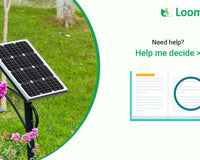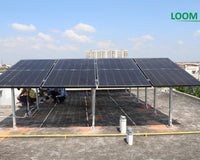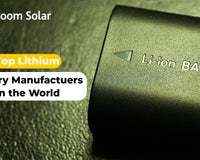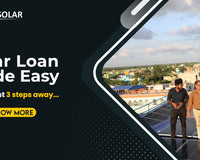Commercial units, such as nursing homes need 24*7 electricity to run necessary and critical appliances. The main appliances used in healthcare centres are lights, fans, security cameras, air conditioners, computers, printer, internet, water pump, x-ray machine, operation theatre appliances, and more. Generally, sanction load of commercial buildings starts from 15kW, 3 Phase goes to building needs. A nursing home runs 365 days and 24*7, that’s why the electricity bill of this unit is very high. However, the nursing homes still face the problem of power cut or low voltage, in which case they use diesel generators. Electricity demand is rising on a year-on-year basis; hence business owners are planning to install rooftop solar to reduce their electricity expense.
Rooftop solar system installation is a long-term investment that gives 5x+ returns in 25 years in the commercial sector. In this blog, you will know how to install rooftop solar for nursing home or any other commercial units (Rice mills, Godown, Nursing Home, Manufacturing Plants, Wedding Halls, shopping malls, Restaurants, Training Institutes / Hostels / Colleges / Schools, Government Offices and Corporate Offices). Let’s continue reading…
How to decide rooftop solar capacity?
An engineer visit to a site is of utmost importance as he is the one who is equipped both technically and professionally to advise us about our solar system installation. He will guide you about the number of solar panels, load, area of rooftop, rooftop quality, installation process, etc. and make your life easy with all these inputs. You can then take it forward based on his professional advice.
Please visit this link to book an Engineer visit now: https://www.loomsolar.com/blogs/collections/why-is-engineer-visit-required-for-rooftop-solar-installation
How does 30kW rooftop solar system work?
The 30 kW solar system works with the help of system grid, solar power, and generator. In order to run the grid connected solar system, 220V-240V grid electricity is required. In case of power outages or low voltage this system automatically starts working on the generator. That is why it is important to install generator synchronization system here.
What are the three main benefits of 30kW solar?
1. Electricity Bill: The main purpose of installing an on-grid solar system is to reduce your electricity bills. You can adjust the usage depending upon peak demand hours and hence end up paying no peak demand charges. These are the higher rate of charge that the utility charges for using the grid during high-demand hours. Also, you end up paying less on electricity bills and earn more through Net Metering.
2. Tax Rebate: A solar system offers a good investment option. It has 5 years as payback time and provides free electricity for the next 25 years. You can convert your own property into a revenue-generating avenue by investing in solar and achieving ROI in just 4-5 years. A user can avail of government subsidies and other incentives to install on-grid solar systems.
3. Good for The Environment: It goes without saying that a solar system is good for the environment as it reduces dependence on fossil fuel based power generation. If one has its own power generating unit, he does not have to depend on the external power from the grid that uses thermal power. Hence using solar power can help reduce your overall carbon footprint.
How can I do Rooftop Solar Financial Analysis?
Avg. The cost of a 30kW grid connected solar system is Rs. 18,00,000 to Rs. 30,00,000 including all costs. The price of this rooftop solar system can vary depending upto installation areas, brands, and installation team.
Installing a solar system is a long term investment and as with other investment options, we want to know the returns from this investment. You can use our Solar Calculator to know all about this: https://www.loomsolar.com/blogs/calculator/solar-calculator
Just answer a basic question like Total Roof Top Area, your average Electricity Cost, Solar Panel Capacity you want to install, or your budget and then sit and relax. We will do the calculation for you. A normal 30 kW solar system generates 9,00,000 units in its life time. You can then compare it with the electricity rates (which keeps increasing every year) to get a sense of financial gain.
Can I install rooftop solar on loan or easy emi?
As we have already said solar is a big investment in one’s life time and it sure does entail a large investment sum. For some people, this might be challenging as it is not always possible to shell out the sum in one go. Hence to solve this problem, the government has introduced solar finance ie. You can avail a loan for installing a solar system at your establishment and pay easy EMIs for the same. It is the same as when buying other consumer durables like homes, cars, phones etc. Read more about Solar Finance here: https://www.loomsolar.com/pages/solar-loan
What are the main components of rooftop solar?
| 1. | Name of the Company | Sanyuka Health Care |
| 2. | Proposed Project Location | Amrambag |
| 3. | District Name | Hooghly |
| 4. | State | West Bengal |
| 5. | Proposed Power Plant Capacity | 30kWp |
| 6. | Technology | Solar Photovoltaic |
| 7. | Location of the Earth |
(i) Latitude : 22.8765° N (ii) Longitude : 87.7910° E |
| 8. | Altitude | 15 m (118 ft.) |
| 9. | Average annual solar isolation | - |
| 10. | Nearest Town | Ghatal |
| 11. | Nearest Airport | Netaji Subhas Chandra Bose International Airport |
| 12. | Nearest Railway Station |
Arambagh Railway Station
|
| 13. | Type of Module Proposed | Shark 535W Solar Panel, 60 |
| 14. | Type of Inverter proposed | String Inverter |
| 15. | Type of Inverter capacity | 25kW, 3 Phase |
| 16. | Projected Gross Energy Production per year | 36,000 kW / 36MW @100% grid availability |
| 17. | Installed by | SR Enterprise |
1. Solar Panel - Solar panels are the main components of the on-grid solar system. They comprise more than 50% of the total cost of a solar system and are the components that capture solar energy and convert solar energy into electrical energy.
2. Inverter - Inverters help in converting the DC output produced from the solar panel into AC supply.
3. Panel Stand - Panel stands are also a major component of the entire solar system. Some people do not give much heed to this component and try and save a few bucks by using a low-quality stand. However, remember that this stand will support the solar panels and if the stand is not sturdy your solar panels could just fall resulting in a heavy loss. It is the skeletal structure holding the panel in the proper position. These stands are generally made of aluminum or galvanized iron. Solar panel stands can be fixed or movable to track the sun.
4. Solar Wire - Solar Wire or Solar Cable is the medium through which electricity is transferred from solar panels to the inverter. Generally, there are two types of wires in the market, such as AC Wire and DC Wire. It is called a solar wire as the solar panel output is DC current.
5. DCDB / ACDB - DC Distribution Board or DCDB is used for connecting the output power from the solar panel to the input of the inverter while AC Distribution Board or ACDB distributes the electrical power from a solar inverter to the AC load system through an energy meter.
6. Earthing Kit - An earthing kit is used to protect the on-grid solar system from thunder.
7. Lighting Arrestor - Lightning Arrestor is used to protect the on-grid solar system from lightning
8. Net Meter & Solar Meter - Net metering is a special metering and billing agreement between utilities and their customers, which facilitates the connection of small, renewable energy-generating systems to the power grid. It is an important component in an on-grid solar system as it keeps the reading to claim credit in your future electricity bills. For solar energy, Net Metering is also very important as solar energy unlike other forms of renewable energy is produced a lot in residential and commercial segments.
9. Safety Equipment - To safeguard the solar system from damages such as lightning and other faulty conditions, protection devices are used. These comprise of surge arrestor, circuit breaker, grounding method, etc.
10. Installation Accessories - These include accessories like wires, cabling, mounting structures, junction boxes, etc.
Bill of Materials: https://www.loomsolar.com/collections/on-grid-solar-system
Does rooftop solar system work in rainy and cloudy weather or power cut duration?
Yes, it generates 30%-40% electricity in the monsoon season as compared to the summer season. An ideal solar power plant of 1 kW generates 4-5 units per day.
How to choose best rooftop solar installers in my city?
Step 1: Installation Portfolio – One should be well aware of the reputation of the installer in the city and check his previous installation projects before proceeding. He can also go and meet the other customers and enquire about after sale services, maintenance, and about the entire installation process. Once satisfied he should proceed.
Step 2: Local Presence – It is important that the installer has done some work in the city to gain customer trust. The installer’s credibility is of utmost importance to build customer confidence. Hence, it is important for the installer to have a decent local presence in the city to gain customers. Try to pick someone who is located nearer to you.
Step 3: Awareness – It is important to raise public awareness about solar. There are still major cities that have negligible solar installations. The installers in the city need to work hard to raise this awareness and educate people about the advantages of installing solar. This way they will also gain a good customer base.
How to install 30 kW Rooftop Solar for Commercial Sector?
Step 1: Site Survey
An engineer will help you in this step. He will advise regarding the site – if the rooftop is sturdy, if the directions are correct, is there any shade, etc. A minimum of 100 square feet is required for every Kilowatt of installation. To avail net metering ie. To get credit for excess electricity generated by your system you need a feasibility report. You can apply net meter for feasibility report or you can apply net meter after rooftop solar installation.
Step 2: Rooftop Solar Design
Given the area available on the rooftop, the direction of the sun, any shade area, etc. you can design your rooftop solar system. Also, based on your electricity requirement, you need to decide the capacity of the system. For eastern regions in India, an inclination of 180 degrees is recommended. If you have a tin roof, make sure the panels are properly clasped with the help of in plugs.
Step 3: Panel Stand Installation
If you are going to install solar panels on the rooftop but also wish to use the area beneath it, make use of a solar panel stand. It will give proper structure and elevation to the installation and also leave the area free for you to use.
Step 4: Mounting Solar Panels
Step 5: Inverter Installation
27 kW three phase inverter has been used for this installation.
Step 6: Solar Wiring (Commissioning)
- Solar Panels to Solar Panels
- Solar Panels to DCDB
- DCDB to Solar Inverter
- Solar Inverter to ACDB
- ACDB to Main Distribution Board
- Main Distribution Board to Net Meter
- Net Meter to Electricity Transformer
Step 7: Earthing & Lighting Arrester Installation
An earthing kit is used to protect the on-grid solar system from thunder and Lightning Arrestor is used to protect the on-grid solar system from lightning. This will help protect the solar system in case of lightning and thunderstorms.
Step 8: No Export Setup
For a grid-connected solar system, any excess power generated can be sold back to the grid and the customer will be credited for that. Despite nearly all the Indian states announcing net metering policies for rooftop solar, there are practical issues around grid integration and DISCOM finances. Few states like WB, still not very sure of this policy and customers are still preferring an off-grid system. With time, this awareness will surely increase.
Step 9: Online Monitoring Setup
With technology advancement, it is now easy to track the system’s performance with a mere click on your mobile phone from any corner of the world. This helps in quick redressal of any issue that crops in.
Step 10: Testing
Once the initial setup is complete, it is important to run a trial in front of the installer to make sure that everything is working fine and there is no faulty connection. Once you are satisfied and understand the working you can use the same peacefully.
Step 11: Prepare Documentations for Net Metering
Net metering is a special metering and billing agreement between utilities and their customers, which facilitates the connection of small, renewable energy-generating systems to the power grid. It is an important component in an on-grid solar system as it keeps the reading to claim credit in your future electricity bills. For solar energy, Net Metering is also very important as solar energy unlike other forms of renewable energy is produced a lot in residential and commercial segments. To avail the benefit of net metering a customer needs to prepare certain documentation and present it to the authorities before starting. Just fill in an application form with details like your postal address and few of your personal data like name, mobile number, email address, etc. You also have to submit the following documents for verification:
- Latest Electricity Bill
- Aadhar Card
- Application No
Step 12: Apply Net Meter
Once the application is successfully submitted, just login on the website to check the latest updates.
Step 13: Electricity Bill Adjustment
As already discussed, net metering helps you to claim a credit on your electricity bill for any excess power that your system generates. Basically, it is the power that you are sending back to the grid and its value is adjusted with the electricity bill that you owe to the department. If you generate excess than you use you receive a credit to your bill.
Step 14: Tax File Return
You can also claim income tax benefits by installing solar panel system at your establishment. Solar producers can claim upto 33% of their total expenses (accelerated depreciation) over a period of three years. There are anti-dumping inclusions as well as excise and custom duty exemptions on solar parts and products. Then there are capital subsidies (40% subsidy on benchmark capital costs on offer for units of up to 3KW capacity, and 20% for larger units upto 10 KW) which the government grants for installing solar systems at your homes/ office, etc.
How can I get solar insurance of my rooftop solar?
Like any other valuable commodity, solar products also need insurance. A solar panel is exposed to rain, storm, lightning, heat and cold and is subject to excessive wear and tear and there is a danger of fire and theft. All these make it critical to insure your solar products. Many imminent insurance players offer solar insurance as well. Contact your insurance partner in event of a loss, they will conduct a survey with a proper estimate for loss and reimburse you accordingly. You also need to deposit certain documents for the claim like your claim form, invoice, estimation for loss, FIR copy, etc.
Why choose Loom Solar?
- India's No. 1 Solar Panel Manufacturer that manufacturers high efficiency solar panels & lithium battery
- 5 years rooftop solar installation portfolios in residentials & commercial sectors
- Implements Engineering in Rooftop Solar that saves electricity bills as well as rooftop space also
- Awarded by government and private bodies, such as Start-up India, Amazon, D2C, etc.
- 100+ People team, 2 offices, 1 manufacturing plants, 3 countries presence












